| Back to Back Issues Page |
 |
|
Bangkok Travelbug April11 Viharn Sien, Pattaya – Abode of the Gods March 30, 2011 |
| Hello
History of Viharn Sien Viharn Sien, Temple of Immortals (Sien – immortals in Taoist legends) or Abode of the Gods is a showpiece of Chinese/Thai architecture and art and symbolizes of the close relationship between the ethnic Chinese in Thailand and China. 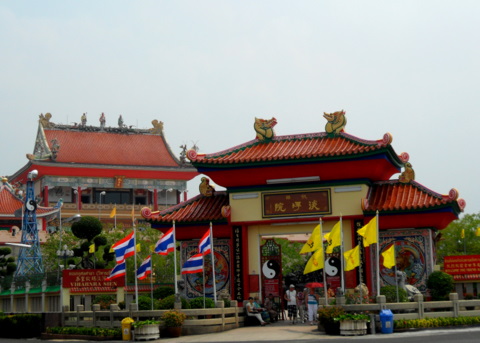
Viharn Sien – Abode of the Gods The temple covers slightly over 1 hectare of land and displays Chinese works of art, paintings and sculpture contributed by China and the Thai Chinese. Viharn Sien is the brainchild of Master Sa- Nga Kulkobkiat, a Feng Shui master who initiated, designed and supervised the construction of this project. Master Sa-Nga (18 October 1925 – 22 August 2003) was born in Thailand and grew up in China. He was instrumental in fostering close cultural ties between China and Thailand. From a royal grant of land in 1987, work commenced on 6 June 1988 9:19 am a timing determined by HM the King. Viharn Sien was officially opened on 24 December 1993 by HM the King. The pavilion was presented to HM the King as a gesture of gratitude of the people. It displays a blend of Buddhist, Confucianism and Taoist art with several contributions from China. There’s another pavilion similar to Viharn Sien in Chaozhou, Guangdong. Table of contents Attractions of Viharn Sien Let’s take a tour of this spectacular showpiece of Chinese art and sculpture. Outside the temple Before you enter the temple, stroll through garden by the scenic lake and relax over a picnic lunch by the lake. 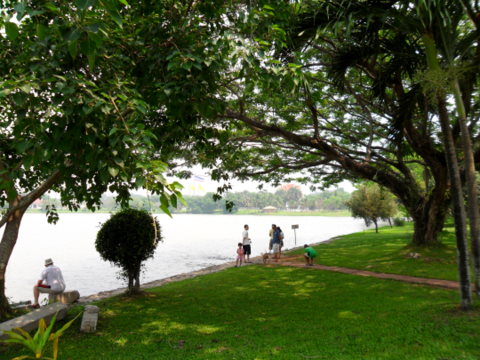
By the lake outside Viharn Sien The inner courtyard As you cross the arch over the main entrance and enter the inner courtyard, turn round and look at the words over the arch. These were written by Dr Sun Yat Sen’s son in praise of Master Sa-Nga. 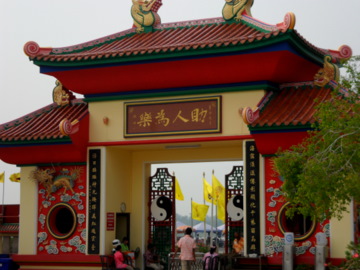
"Happiness is derived from helping others" The Laughing Buddha or Budai is easily recognized by his jolly expression and protruding belly. He is the loving and friendly one and represents contentment and abundance. According to legend the Laughing Buddha was a monk who was the reincarnation of the Maitreya (the future Buddha). 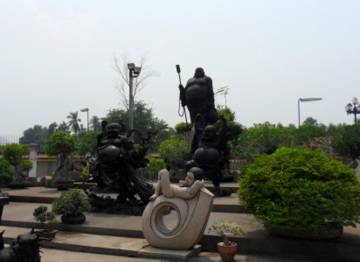
The Laughing Buddha The Eight Immortals (Ba Xian) are famous characters in Taoism; seven men and a woman with the power to give life and destroy evil. They are the champions of good and righteousness, the protectors of the weak and fighters against evil. In the tale Eight Immortals Cross the Sea, the Eight Immortals take a journey over the turbulent East Sea. They evoke all their divine powers to overcome the harsh elements and complete their journey. 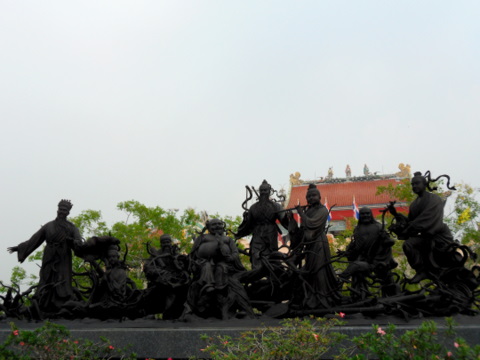
Ba Xien Guo Hai – Eight Immortals Cross the Sea The moral of the story is to use all of one’s abilities to overcome difficulties in life. Images of the Eight Immortal connote prosperity and good fortune. 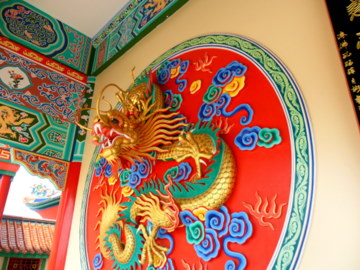
Dignity and power Dignity and power is embodied in the Chinese dragon which has the power to control the weather. Dragons represent the will and ideals, the very soul of the Chinese people. It is not surprising that the wall commemorating the official opening of Viharn Sien is topped with a golden dragon. 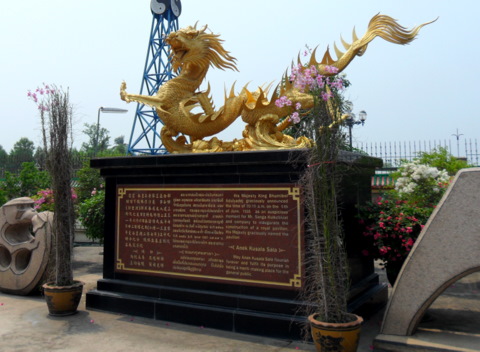
Dragon commemorating the opening of Viharn Sien These granite sculptures are presented to Viharn Sien by the city of Guangdong 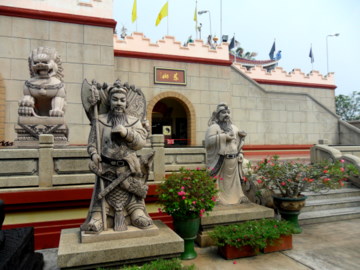
Gifts from Guangdong Power and prestige, nobility and dignity are hallmarks of the lion. A pair of lions is usually placed at the main gates or doors of traditional Chinese buildings. 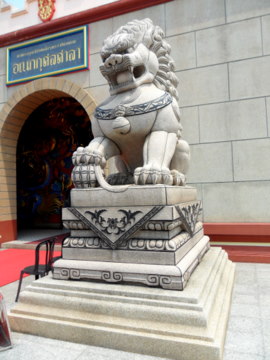
Lion (male) with his right paw on a ball The lion on the left side (male) of a palace symbolizes power and deterrence. The lion on the right (female) symbolizes the multiplicity of the family. 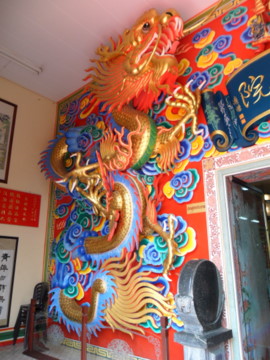
Dragons at the door There are more dragons at the entrance to the main building. In Viharn Sien there are a total of 31 dragons to signify BE 2531 (1988, the year work commenced on the pavilion). The words over the door to the main building are based on the original calligraphy written by Pu Jie, younger brother of Pu Yi, last emperor of China who reigned from 1908 – 1912. The declaration of the Chinese Republic by Dr Sun Yat Yen in October 1911 ended 2,000 years of imperial rule. 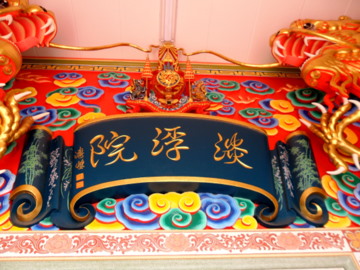
Dan Fu Yuan – Chinese name for Viharn Sien Ground floor Once you have entered the main door, turn around and admire the nine dragons over the arch in honour of the present king, King Rama IX. 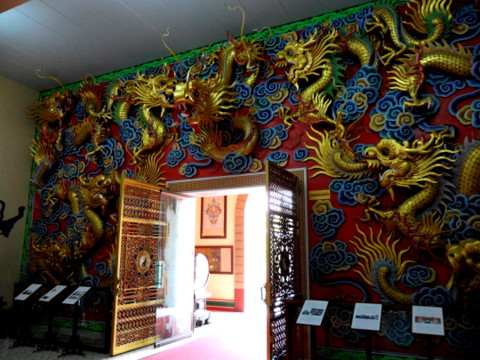
Nine dragons for the Ninth Reign The Diamond Kings of Heaven (Tien Wang), guardians of the four cardinal directions, stand guard two on each side of the entrance to the main hall. 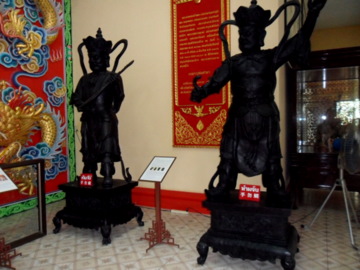
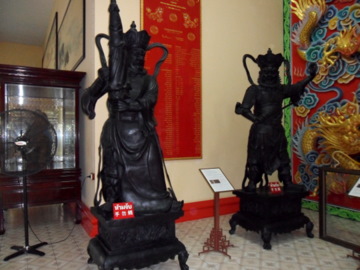
Diamond Kings of Heaven The entire ground floor is filled with all types of statues representing the gods, deities or legendary figures whose statures have endured over the centuries. I have only managed to identify some of them. 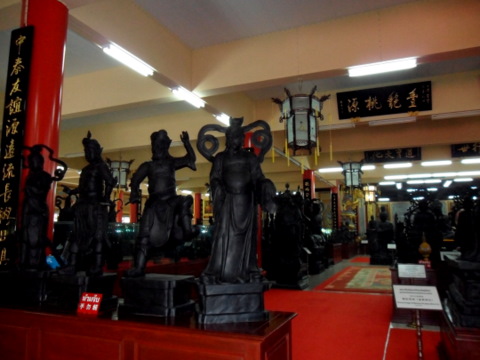
Displays in the main hall on the ground floor These Terracotta statues are of 18 arahans (or luohan in Chinese) Buddhist saints who have achieved enlightenment. According to legend, the first portraits of the 18 luohans were painted by a Buddhist monk Guan Xiu, in 891 A.D. Guan Xiu lived in Chengdu, in what is today's Sichuan Province. As he was skilful in painting, calligraphy and poetry, the luohans chose him to paint their portraits. They appeared to him in his dreams to make this request. Guan Xiu painted the 18 luohans in the sequence in which they appeared in his dreams; Deer Sitting, Happy, Raised Bowl, Raised Pagoda, Meditating, Oversea, Elephant Riding, Laughing Lion, Open Heart, Raised Hand, Thinking, Scratched Ear, Calico Bag, Plantain, Long Eyebrow, Doorman, Taming Dragon and Taming Tiger. 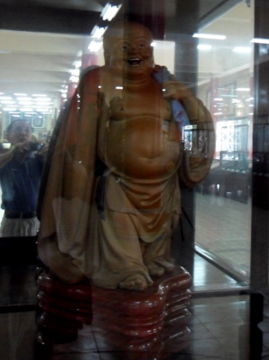
Calico bag – compassion and kindness Each arahan or luohan represents a virtue; Deer sitting - spiritual awakening, contentment, Taming tiger - subduing desire, anger, greed and hatred. 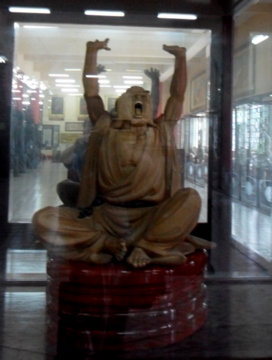
Raised hands – contentment These statues of the 18 arahans were hand-made from Terracotta clay by a Chinese sculptor who took two years to complete the task. The 18 arahans were presented to Viharn Sien by Guangdong city. 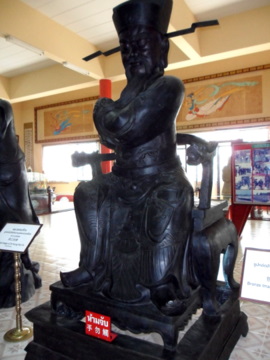
Bao Gong - justice and integrity Bao Kong was the legendary judge who lived in the 10/11th C during the Song Dynasty who was renowned for his sense of justice. 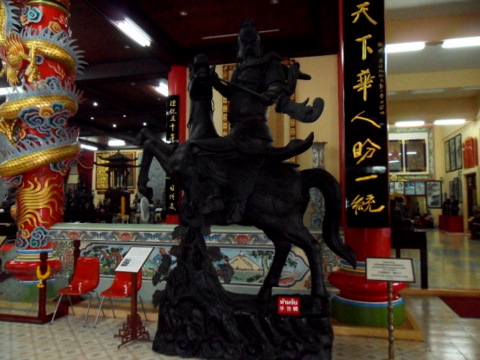
Guan Gong – honour and courage Kuan Yu or Guan Gong is commonly known as the God of War noted for his honour, loyalty, integrity, justice, courage and strength. An exemplary leader and shrewd tactician, Guan Gong is recognized by his long black beard and broad sword on a long handle. Please see the Kuan Yu Shrine in Bangkok 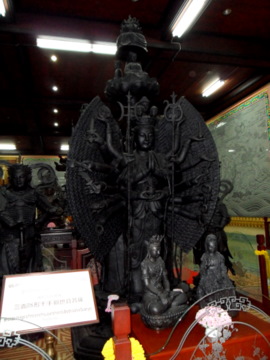
Guan Yin - compassion Kuan Yin or Goddess of Mercy is known for her compassion and forgiveness. She sacrificed both eyes and both arms to save her father who was critically ill, even though he ill-treated her all her life. When her father recovered and realized who saved him, he begged his daughter for forgiveness. As an act of atonement he ordered a monument for her. 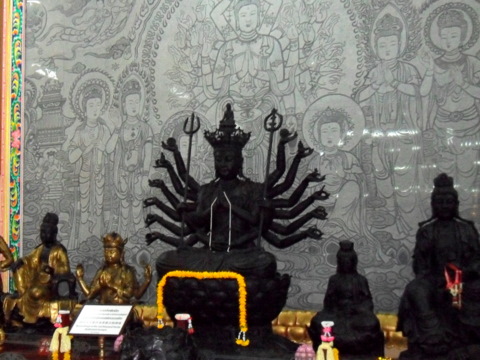
Thousand hand Bodhisattva Kuan Yin Some versions of Kuan Yin, depict her with a thousand hands with an eye in each palm; a thousand hands to help those in need and a thousand eyes to see who are in need for one who has made the supreme sacrifice and attained enlightenment through compassion and mercy. "Father, I have suffered no pain. Having given up these human eyes, I shall see with diamond eyes. Having yielded the mortal arms, I shall receive golden arms. If my calling is true all this will follow." Please see the Kuan Yin Shrine in Bangkok The pair of chariots displayed here is modelled after the chariots of Emperor Qin Shi Huang, who ordered the construction of the Terracotta Army. 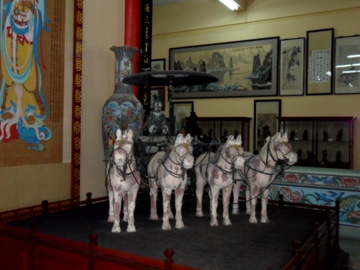
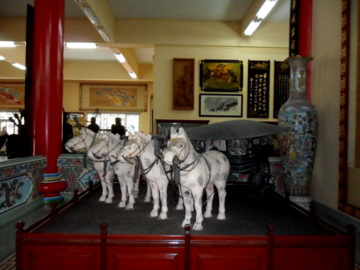
The Emperor’s chariots There’s more on him in the next section. This room with Chinese antique furniture is in honour of Master Sa-Nga Kulkobkiat 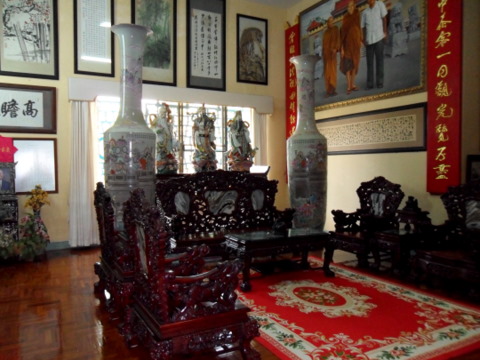
Chinese antiques Second floor The courtyard on the second floor has a huge array of bronze statues relating to Chinese history. Visitors just love these bronze figures in various martial stances representing the 19 schools of Shaolin martial art affiliated to the Shaolin Monastery. 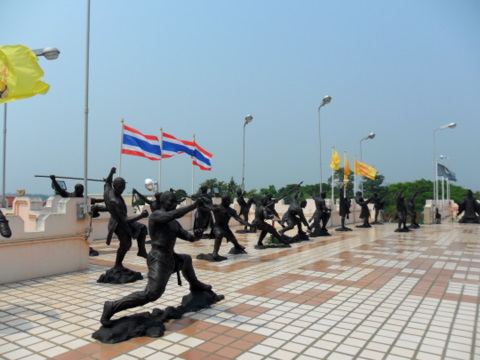
19 schools of Shaolin 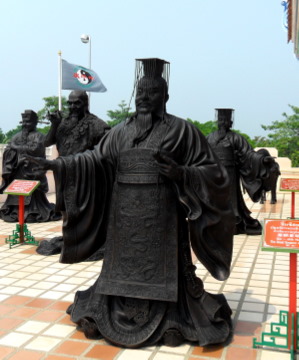
Emperor Qin Shi Huang (259 BC – 210 BC) Emperor Qin Shi Huang was the first emperor of a unified China. He ordered the construction of the Great Wall of China and the famous Terracotta Army to accompany him in his afterlife in his mausoleum in Chinese city of Xi'an. The labourers who built the mausoleum were also entombed with him to keep the location of his tomb a secret. So were his childless concubines!! These soldiers were discovered in 1974 by a farmer. In 1987, UNESCO designated Xi'an a World Cultural Heritage Site. While you are on the second floor, take a look at the exhibition of Thai art in rooms on both sides of the main building. 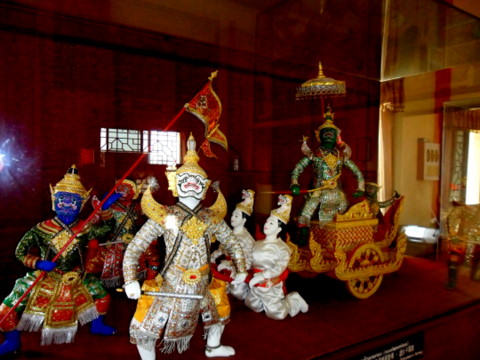
Puppets in the Thai art exhibition room Third floor The altar on the third floor dedicated to Buddha. Paintings depicting Buddha’s life line the walls around the altar. 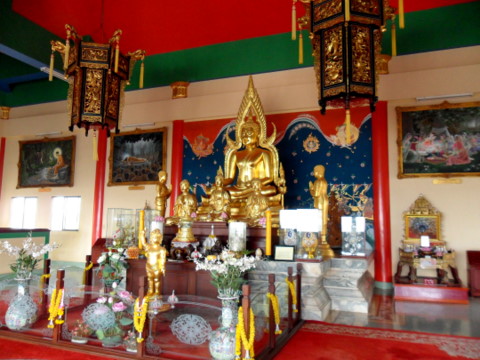
Life of Buddha in paintings There’s also a panoramic view of the bronze statues in the courtyard below. 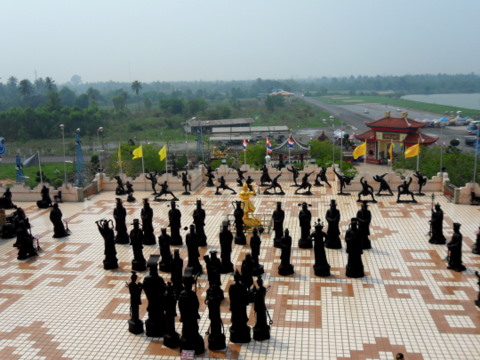
View from the third floor We end our stroll through Viharn Sien, the Abode of the Gods, the Temple of Immortals, extraordinary beings like Kuan Yin, paragons of virtue who serve as guardians and an inspiration to mankind. Others like Emperor Qin Shi Huang, through their eccentricities, have left a cultural heritage for the world. Viharn Sien is the fruition of one man’s vision to create a cultural heritage for posterity. The efforts of Master Sa-Nga Kulkobkiat have resulted in this cultural treasure trove. Table of contents The Terracotta statues Long before I visited Viharn Sien, my friends in Pattaya have told me about the "Terracotta warriors" in a Chinese temple in Pattaya. Even some web sites on Viharn Sien have mentioned these warriors. I immediately had images of the Terracotta Army in Xi'an. From my visit, it wasn’t quite so. Sure, there are Terracotta statues but these are of the 18 arahans or Buddhist saints. These statues were made and presented by China. The pair of chariots looks very much like the pictures of the exhibits in Xi'an. I’m not sure if they are made from Terracotta. There’s also a statue of Emperor Qin Shi Huang but that’s in bronze. Other than these, I haven’t seen anything else related to the Terracotta Army, unless I missed something. Table of contents Khao Chee Chan – Buddha Mountain The other attraction in the Wat Yannasangwararam complex is outdoors, reputedly the biggest Buddha image in the world. It’s an outline of a sitting Buddha, 130 m high and 70 m across and etched into cliff face of a mountain! 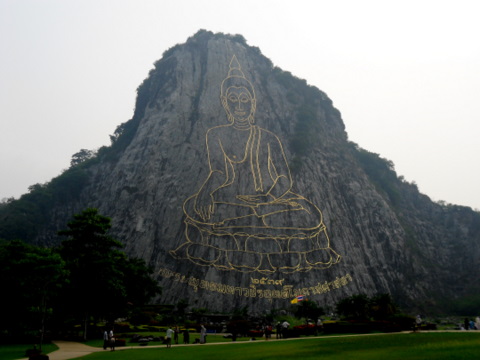
Khao Chee Chan The mountain was much bigger before. It was blasted down by the Americans to get the rocks to build the U-Tapao airbase to the south and also some of the roads in the area in the 1970s during the Vietnam War. A long-time resident of the Pattaya had a slightly different version. The U-Tapao runway is south of this mountain and in a north-south alignment. The mountain was in the flight path of the B52s taking off to the north or landing from the north. To clear the way, large chunks of the mountain had to be blasted away. Whatever the reason, the result is a vertical rock face. In 1996, to commemorate the Golden Jubilee of H M the King’s reign, the Buddha image was carved into the rock by laser and the lines filled with gold leaf. 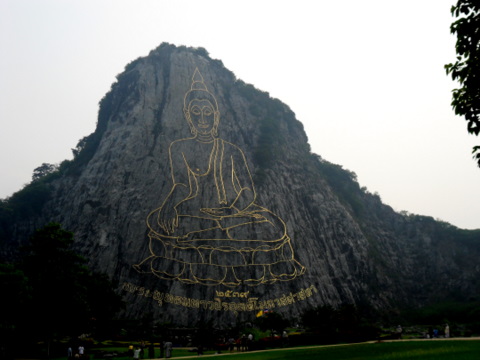
Buddha Mountain There’s a park at the foot of this mountain and busloads of tourists from China were marvelling at the spectacular Buddha Mountain. Table of contents How to get to there Map to Wat Yannasangwararam complex View Wat Yannasangwararam in a larger map How to get to Viharn Sien By public transport From the Victory Monument, take the Bangkok-Sattahip mini-bus. This service will run along Sukhumvit Road. I suggest you don’t drop off at junction leading to Viharn Sien. There were no motor-cycle taxis when I was there. Get off one junction before, the road leading to the Phoenix Golf Club (158 km mark). There’s a Tesco/Lotus mini-market there. There’s a motor-cycle stand there. One-way fare to Viharn Sien is 70 baht. Get his number and call him when you want to return to the junction. When you book your ticket for the mini-bus, get a card form the transport company. For the return trip, call the numbers on the card to tell them you wish to return to Bangkok. The driver will call back to confirm and arrive in about 20 minutes. You must call them; the mini-buses from Sattahip to Bangkok don’t stop along the way unless they are picking up passengers. Fare is 140 baht each way. There’s also a Bangkok-Sattahip mini-bus service from Ekamai, the Eastern bus terminal in Sukhumvit Road near the Ekamai skytrain station. You can also take a tour bus from Ekamai to Pattaya. When you reach the Pattaya bus terminal, there are "song taeow" and motor-cycle taxis there. The Ekamai/Pattaya tour bus is actually faster (1 hour 40 minutes compared to 2 hours for the mini-buses) as it goes on the highway all the way. By car Take the Bangkok-Chonburi Motorway 7 all the way to Pattaya. Then get on to Sukhumvit Road and proceed till the 161 km mark. Follow the sign and turn left to Viharn Sien. Proceed along this road and turn right. You will see a huge lake with several temples around it. Keep going till you get to the temple with a Chinese design. Admission to Viharn Sien is 50 baht. Table of contents My thanks My thanks to Izzy Friedman for showing me around the area and most of all for the delicious Aussie steak and bacon pie at Shenanigans, Pattaya. Cheers Izzy! Table of contents Next month The Sanctuary of Truth, Pattaya 
Book hotels in Pattaya 
If you enjoyed reading this e-zine, please forward it to a friend. If you received this from a friend and found it interesting, please subscribe at Bangkok Travelbug. What you think of the Bangkok Travelbug? We love to hear from you What other subscribers have said Till next month then. Eric Lim Find us on Facebook Stay updated with what’s new at Tour Bangkok Legacies. Copy the link below and paste it into your Google Reader, NetNewsWire or your favorite feed reader. https://www.tour-bangkok-legacies.com/tour-Bangkok- legacies.xml If you use My Yahoo! or My MSN, head over to my home page and click on the button for your favourite Web-based feed reader. Visit our home page at Tour Bangkok Legacies. Copyright@2008-2009 Tour Bangkok Legacies All rights reserved |
| Back to Back Issues Page |